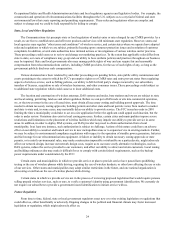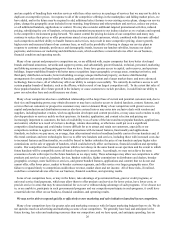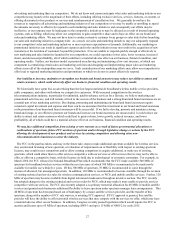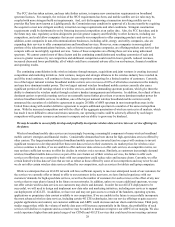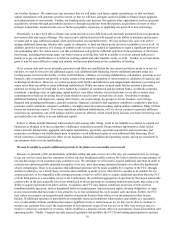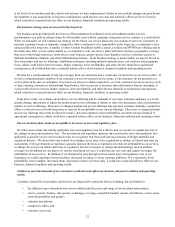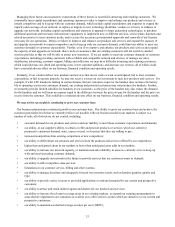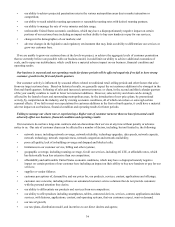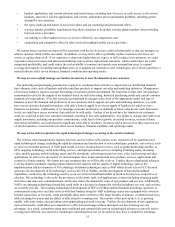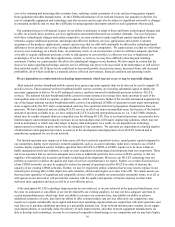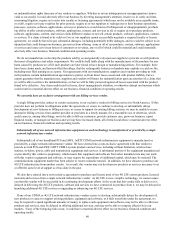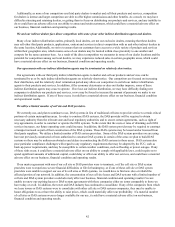Metro PCS 2011 Annual Report Download - page 44
Download and view the complete annual report
Please find page 44 of the 2011 Metro PCS annual report below. You can navigate through the pages in the report by either clicking on the pages listed below, or by using the keyword search tool below to find specific information within the annual report.33
Managing these factors and customers' expectations of these factors is essential in attracting and retaining customers. We
continually incur capital expenditures and operating expenses in order to improve and enhance our products and services to
remain competitive and to keep up with our customer demand, which include capital expenditures and expenses to expand the
capacity and coverage of our network, to replace or migrate to new technology platforms, vendors or services, to enhance or
upgrade our networks, including capital expenditures and expenses to upgrade to future generation technologies, to purchase
additional spectrum and necessary infrastructure equipment, to implement new or different services, service plans, handsets and
related accessories to meet customer needs, and to secure the necessary governmental approvals and renewals of our licenses
necessary for our operations. Delays or failure to improve and enhance our products and services and expand the capacity of
and upgrade our network to remain competitive and to keep up with our customer demand, could limit our ability to meet our
customer demands or customer expectations. Further, even if we improve and enhance our products and services and expand
the capacity of and upgrade our network, there can be no assurance that our existing customers will not switch to another
wireless provider or that we will be able to attract new customers. If we are unable to meet our customer demands or customer
expectations, including providing customers with a reliable and compatible network and devices, or manage our sales,
distribution, advertising, customer support, billing and collection, we may have difficulty attracting and retaining customers,
which could increase our churn and operating costs, lower customer additions, and decrease our revenue, all of which could
have a material adverse effect on our business, financial condition and operating results.
Similarly, if our vendors deliver new products and services that do not work or work as anticipated, fail to meet customer
expectations, or fail to operate properly, we may not receive revenue on our investment in such new products and services. For
example, if a 4G LTE handset is lacking in certain features that our customers expect or the handset does not have the battery
life or operating system our customers demand, our existing and potential customers may not purchase the handsets. Further,
we presently provide limited subsidies for handsets to our customers, so the price of the handset may also reduce the demand
for the handsets and we will incur an expense equal to the difference between the price we pay for the handset and the price we
receive from the customer. This could have a material adverse effect on our business, financial condition and operating results.
We may not be successful in continuing to grow our customer base.
Our business plan assumes continued growth in our customer base. Our ability to grow our customer base and achieve the
customer penetration levels that we currently believe are possible with our business model in our markets is subject to a
number of risks, all of which we do not control, including:
• customer demand for our products and services and our inability to meet those customer expectations and demands;
• our ability, or our supplier's ability, to obtain or offer and provide products or services which our current or
prospective customers demand, want, expect or need, or for prices that they are willing to pay;
• increased competition from existing competitors or new competitors;
• our ability to differentiate our products and services from the products and services offered by our competitors;
• higher than anticipated churn in our markets or lower than anticipated gross adds in our markets;
• our ability to increase our network capacity, or maintain network reliability, in areas we currently serve to keep up
with and meet increasing customer demand;
• our ability to upgrade our network in the future to provide services that our customers wants or demand;
• our ability to offer competitive data services;
• limitations in our customer service, billing and other systems;
• our ability to manage inventory and adequately forecast our inventory needs, such as handset quantity, quality and
type;
• our ability to provide service in areas or provided applications or content demanded by our current and prospective
customers;
• our ability to attract and retain indirect agents and dealers for our products and services;
• our ability to increase the relevant coverage areas in our existing markets, to expand our roaming arrangements to
areas that are important to our customers or to allow us to offer services at rates which are attractive to our current and
prospective customers;
• our ability to maintain our desired average revenue per user (ARPU);



